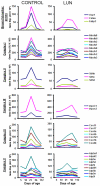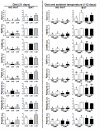Inherent plasticity of brown adipogenesis in white fat of mice allows for recovery from effects of post-natal malnutrition
- PMID: 22383960
- PMCID: PMC3286483
- DOI: 10.1371/journal.pone.0030392
Inherent plasticity of brown adipogenesis in white fat of mice allows for recovery from effects of post-natal malnutrition
Abstract
Interscapular brown adipose tissue (iBAT) is formed during fetal development and stable for the life span of the mouse. In addition, brown adipocytes also appear in white fat depots (wBAT) between 10 and 21 days of age in mice maintained at a room temperature of 23 °C. However, this expression is transient. By 60 days of age the brown adipocytes have disappeared, but they can re-emerge if the adult mouse is exposed to the cold (5 °C) or treated with β3-adrenergic agonists. Since the number of brown adipocytes that can be induced in white fat influences the capacity of the mouse to resist the obese state, we determined the effects of the nutritional conditions on post-natal development (birth to 21 days) of wBAT and its long-term effects on diet-induced obesity (DIO). Under-nutrition caused essentially complete suppression of wBAT in inguinal fat at 21 days of age, as indicated by expression of Ucp1 and genes of mitochondrial structure and function based upon microarray and qRT-PCR analysis, whereas over-nutrition had no discernible effects on wBAT induction. Surprisingly, the suppression of wBAT at 21 days of age did not affect DIO in adult mice maintained at 23 °C, nor did it affect the reduction in obesity or cold tolerance when DIO mice were exposed to the cold at 5 °C for one week. Gene expression analysis indicated that mice raised under conditions that suppressed wBAT at 21 days of age were able to normally induce wBAT as adults. Therefore, neither severe hypoleptinemia nor hypoinsulinemia during suckling permanently impaired brown adipogenesis in white fat. In addition, energy balance studies of DIO mice exposed to cold indicates that mice with reduced adipose stores preferentially increased food intake, whereas those with larger adipose tissue depots preferred to utilize energy from their adipose stores.
Conflict of interest statement
Figures




Similar articles
-
Mitochondrial turnover: a phenotype distinguishing brown adipocytes from interscapular brown adipose tissue and white adipose tissue.J Biol Chem. 2015 Mar 27;290(13):8243-55. doi: 10.1074/jbc.M115.637785. Epub 2015 Feb 1. J Biol Chem. 2015. PMID: 25645913 Free PMC article.
-
The effects of early under-nutrition on the development of wBAT and obesity.Adipocyte. 2012 Oct 1;1(4):265-270. doi: 10.4161/adip.21555. Adipocyte. 2012. PMID: 23700544 Free PMC article.
-
Brown fat thermogenesis and body weight regulation in mice: relevance to humans.Int J Obes (Lond). 2010 Oct;34 Suppl 1:S23-7. doi: 10.1038/ijo.2010.179. Int J Obes (Lond). 2010. PMID: 20935661 Review.
-
Genetic variability affects the development of brown adipocytes in white fat but not in interscapular brown fat.J Lipid Res. 2007 Jan;48(1):41-51. doi: 10.1194/jlr.M600287-JLR200. Epub 2006 Oct 14. J Lipid Res. 2007. PMID: 17041251
-
Adipocytes spectrum - From homeostasia to obesity and its associated pathology.Ann Anat. 2018 Sep;219:102-120. doi: 10.1016/j.aanat.2018.06.004. Epub 2018 Jul 3. Ann Anat. 2018. PMID: 30049662 Review.
Cited by
-
Impairment of body mass reduction-associated activation of brown/beige adipose tissue in patients with type 2 diabetes mellitus.Int J Obes (Lond). 2017 Nov;41(11):1662-1668. doi: 10.1038/ijo.2017.152. Epub 2017 Jul 3. Int J Obes (Lond). 2017. PMID: 28669988
-
Global Adipose Tissue Remodeling During the First Month of Postnatal Life in Mice.Front Endocrinol (Lausanne). 2022 Feb 17;13:849877. doi: 10.3389/fendo.2022.849877. eCollection 2022. Front Endocrinol (Lausanne). 2022. PMID: 35250892 Free PMC article. Review.
-
Mitochondrial turnover: a phenotype distinguishing brown adipocytes from interscapular brown adipose tissue and white adipose tissue.J Biol Chem. 2015 Mar 27;290(13):8243-55. doi: 10.1074/jbc.M115.637785. Epub 2015 Feb 1. J Biol Chem. 2015. PMID: 25645913 Free PMC article.
-
Inducible brown adipocytes in subcutaneous inguinal white fat: the role of continuous sympathetic stimulation.Am J Physiol Endocrinol Metab. 2014 Nov 1;307(9):E793-9. doi: 10.1152/ajpendo.00033.2014. Epub 2014 Sep 2. Am J Physiol Endocrinol Metab. 2014. PMID: 25184993 Free PMC article.
-
Early and Long-term Undernutrition in Female Rats Exacerbates the Metabolic Risk Associated with Nutritional Rehabilitation.J Biol Chem. 2015 Jul 31;290(31):19353-66. doi: 10.1074/jbc.M114.549204. Epub 2015 Jun 23. J Biol Chem. 2015. PMID: 26105051 Free PMC article.
References
-
- Hirning U, Schmid P, Schulz WA, Kozak LP, Hameister H. In developing brown adipose tissue c-myc protooncogene expression is restricted to early differentiation stages. Cell Differ Dev. 1989;27:243–248. - PubMed
-
- Giralt M, Martin I, Iglesias R, Vinas O, Villarroya F, et al. Ontogeny and perinatal modulation of gene expression in rat brown adipose tissue. Unaltered iodothyronine 5′-deiodinase activity is necessary for the response to environmental temperature at birth. Eur J Biochem. 1990;193:297–302. - PubMed
-
- Xue B, Rim JS, Hogan JC, Coulter AA, Koza RA, et al. Genetic variability affects the development of brown adipocytes in white fat but not in interscapular brown fat. J Lipid Res. 2007;48:41–51. - PubMed
-
- Cousin B, Cinti S, Morroni M, Raimbault S, Ricquier D, et al. Occurrence of brown adipocytes in rat white adipose tissue: molecular and morphological characterization. J Cell Sci. 1992;103(Pt 4):931–942. - PubMed
-
- Himms-Hagen J, Cui J, Danforth E, Jr, Taatjes DJ, Lang SS, et al. Effect of CL-316,243, a thermogenic beta 3-agonist, on energy balance and brown and white adipose tissues in rats. Am J Physiol. 1994;266:R1371–1382. - PubMed
Publication types
MeSH terms
Substances
Associated data
- Actions
Grants and funding
LinkOut - more resources
Full Text Sources
Molecular Biology Databases

